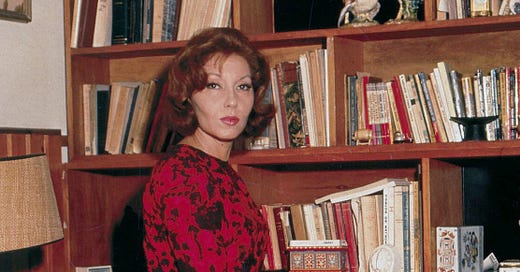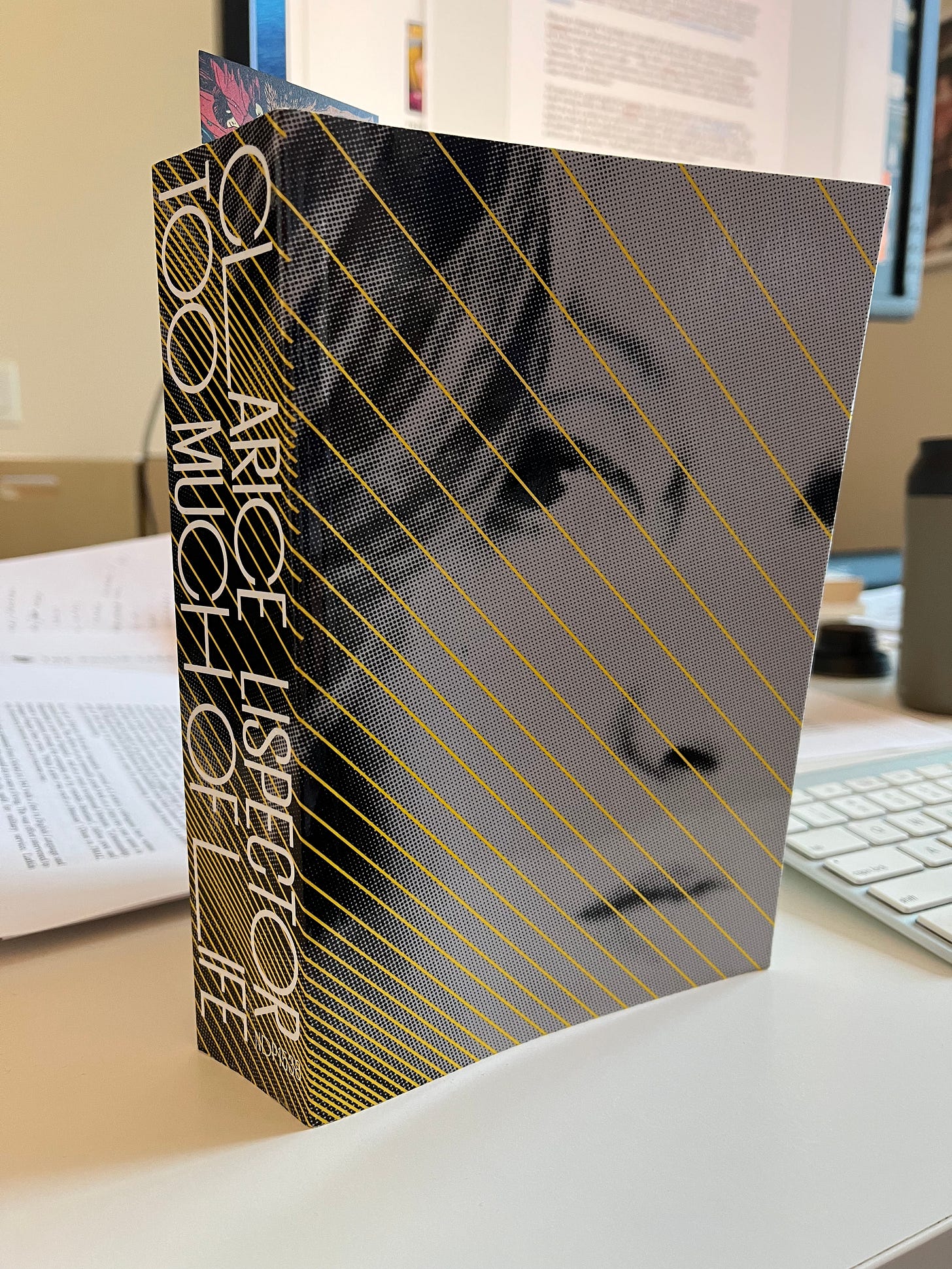Clarice Lispector’s paradoxical certainties
“What gets in the way of writing is having to use words.”
Welcome to the latest issue of Subtle Maneuvers, arriving a day late because of the Labor Day holiday. If you’re not yet a subscriber, you can become one here:
Clarice Lispector (1920–1977)
The other week, I unexpectedly had some time to kill in the middle of the day, so I popped into Skylight Books in search of something to read while I sat at a bar for an hour. The right book would have been short and light; instead, I found myself dropping thirty bucks on a 742-page collection of the Brazilian writer Clarice Lispector’s complete newspaper columns, published between 1967–73 and collected last year in a very sexy New Directions paperback.
What was I thinking? I’m already in the middle of a few books, and I already have a different Lispector book at home that I haven’t read yet. But this brick of fifty-year-old journalism turned out to be an inspired choice for bar-reading. Above, I described the contents as newspaper columns; that’s not exactly right. These are crônicas, described by Giovanni Pontiero as “aphorisms, diary entries, reminiscences, travel notes, interviews, serialized stories, essays: a genre peculiar to Brazil which allows poets and writers to address a wider readership on a vast range of topics and themes.”
The genre was a good match for Lispector, who—like all writers I’m drawn to?—generally found writing terribly difficult. Lispector wrote her first novel, Near to the Wild Heart, in 1942 while she was a 22-year-old law student1 and also working as a journalist. The book began as ideas that she jotted down in a notebook as they occurred to her; over time, “groping in the darkness,” she assembled the fragments into a novel. “When I reread what I’ve written,” she told her lover at the time, “I feel like I’m swallowing my own vomit.”

Writing for a newspaper was, Lispector said, “less impossible,” though, according to her son, she still only wrote when inspiration struck. To manage this with a weekly deadline, Lispector always kept at least five pieces ready to go—these were her “piggy bank,” so that she would never be forced to write in an uninspired state. In a crônica from September 1968, Lispector lamented the uncontrollable nature of her process: “What a shame that I can only write when ‘the thing’ spontaneously arrives. I am thus at the mercy of time.”
The crônicas are, in fact, full of fascinating insights on writing and creativity. Lispector is especially brilliant at articulating the fundamental paradoxes of making art, like in the following statements: “There is a great silence in me. And that silence has been the source of my words.” (2/10/68) “I once said that writing is a curse. . . . Now I say it again: it is a curse, but a curse that saves.” (9/14/68) “When I’m writing, I feel again what is apparently the only paradoxical certainty: that what gets in the way of writing is having to use words.” (5/2/70) “Writing is so often remembering the thing that never existed.” (2/20/71) “This has been perhaps my greatest effort in life: in order to understand my nonintelligence, my feelings, I was obliged to make myself intelligent.” (11/6/71) “I have always been a very bold shy person.”2 (10/14/72) At another point, she approvingly quotes the Portuguese writer Fernando Pessoa: “Speaking is the simplest means of making ourselves unknown.”
Or there’s this brief crônica, from February 2, 1971:
THE MIRACULOUS FISH
So writing is the peculiarity of someone who uses word as bait, with the word fishing not just for words, but more for what lies between the lines. When this nonword nibbles the bait, something is written. Once the between-the-lines has been fished, the word can happily be discarded. But there the analogy ends: on nibbling the bait, the nonword incorporates the indispensable word into itself. What saves it then is unintentionality (I can’t explain it any better. There are times I can’t explain something, and then twenty-five years later, I find a way).
I think this gets at the heart of what makes writing and making art so elusive: The thing you’re “saying” is not the thing you’re saying—it is behind it, or within it—but it also can’t be “said” in any other way. And then, so often, after a work is done, the author is asked to explain it! And there is no explanation; there is just the thing itself. As Lispector writes at another point, “If I had to give my life a title it would be: Searching for the Thing Itself.”
RELATED READING
From the archive:
Thanks for reading! This newsletter comes out every other Monday—and you can help keep it coming by becoming a paid subscriber, buying one of my Daily Rituals books, forwarding the newsletter to a friend, or even just clicking the “like” button below.
“My law studies taught me nothing,” she said, “not even how to protect the copyright of my own books.”
Somewhere else, I read that Lispector referred to herself as “an audacious coward,” a description I love and also something to strive for, maybe?









I’m so happy to see Clarice Lispector here with such kind words. She is one of the most brilliant writers in Brazil. Caio Fernando Abreu - another amazing brazilian writer- once had a quick casual meeting with her. It was the first time he saw her in person. Later, he made a curious description about Clarice in a letter to his friend Hilda Hilst - brazilian poet:
“She is exactly like her books: she conveys a strange sensation, of impressive wisdom and bitterness. She's slow and hardly speaks. She has hypnotic, almost diabolical eyes. And you feel that she no longer expects anything from anything or anyone, that she is absolutely alone and at such a height that no one could ever reach her. Many people must find her extremely unlikable, but I found her beautiful, profound, strange and dangerous."
This letter is included in the book “Três vezes Hilda: biografia, correspondências e poesia (2018). Not sure if this was launch in English.
“The thing you’re ‘saying’ is not the thing you’re saying—it is behind it, or within it—but it also can’t be ‘said’ in any other way. And then, so often, after a work is done, the author is asked to explain it! And there is no explanation; there is just the thing itself.”
This was so helpful for me in terms of understanding why some find writing so difficult while I typically don’t.
Its that I have a totally opposite experience of the relationship between what is written and the “thing” that is being written about. For me, the “thing” only comes into existence when it is articulated in words. Before that there is just a vagueness. It’s my words that give it substance. It is what I say it is. So I can’t go wrong.
I realize there are a lot of problems underlying this POV, but that is what the process FEELS like to me, and I think that is why I seldom get stuck.
I imagine this and your experience are just two of many possibilities. It’s fun to look at them!